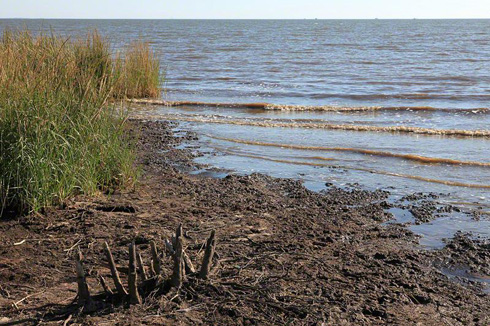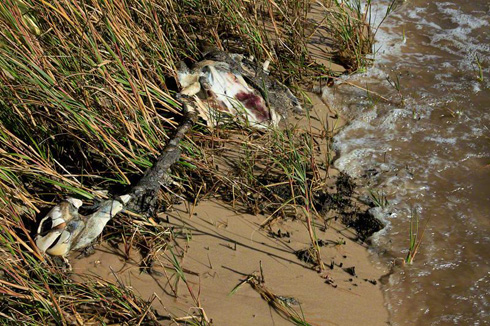Marine Life
A dead jellyfish found on Long Beach, Mississippi, nearby a large amount of the aforementioned thick, brown foam, was tested and found to contain 15 ppm of ethanol, one of the chemicals in the dispersants, along with low levels of n-Butanol, another chemical present in the dispersants that are manufactured by Nalco Holding Company.
Nalco Holding Company has corporate ties to BP.
Based on comparative analysis of Corexit 9500 and the sample collected, the sample appears to contain approximately 500 ppm of dispersant.
Water
A water sample in the same area, taken in an area covered in thick, brown foam, contained propylene glycol, one of the confirmed ingredients of Corexit 9500.
Samples were also taken from a beach in Ocean Springs, Mississippi.
Blood Beach in Ocean Springs, Mississippi. (Photo: Erika Blumenfeld)
A water sample at this area also contained ethelene glycol, as did a water sample taken from a fish pond in the front yard of a resident's home in Ocean Springs.
Another water sample from the beach contained diethylene glycol BE.
Dead sea turtle, Blood Beach, Ocean Springs, Mississippi. (Photo: Erika Blumenfeld)
Additional Sampling and Conclusions
Earlier this month, Louisiana Environmental Action Network, Lower Mississippi Riverkeeper, in conjunction with the Subra Company, released results of sampling in the coastal regions of Louisiana.
Their press release states:
"The wetlands and ecosystem soil/sediment from Atchafalaya Bay eastward to the Louisiana/Mississippi state line contained 6 to 89 individual Alkylated Polynuclear Aromatic Hydrocarbons (PAHs) and Oil Range Organic Petroleum Hydrocarbons (ORO) up to 11,600 mg/kg [ppm] (1.16%) which corresponded to the fingerprint of the BP Louisiana Sweet Crude."
Sixty percent of the soil/sediment samples the groups tested contained up to 18 PAHs in excess of the marine sediment screening levels.
(Note: You can view every article as one long page if you sign up as an Advocate Member, or higher).





